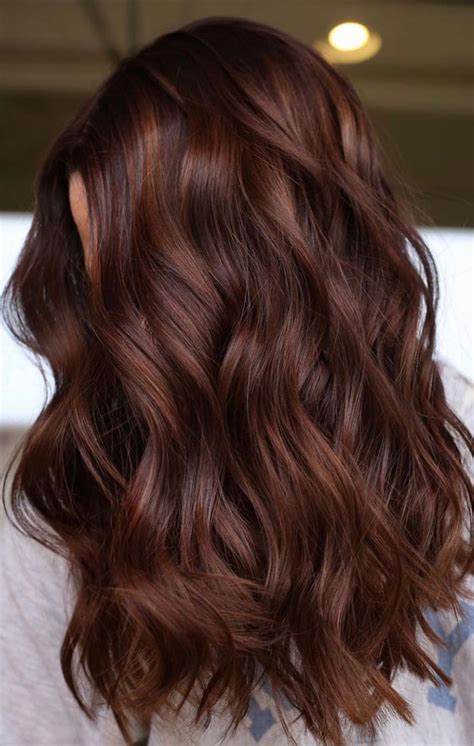Chestnut-colored hair, a warm and inviting shade that exudes sophistication and depth, has fascinated people for centuries. With its natural undertones and versatility in styling, it’s no wonder why this timeless hue continues to captivate hearts.

The Allure of Chestnut
According to a recent survey by the National Hair Council, chestnut-colored hair is among the top preferences for both men and women, with over 40% of respondents expressing a strong attraction towards this shade. Its alluring qualities stem from its ability to complement a wide range of skin tones and enhance facial features.
The Spectrum of Chestnut Hues
The chestnut hair color spectrum spans a diverse range of shades, catering to the individual preferences of each person. From light chestnut, with its delicate honey-brown undertones, to deep chestnut, with its rich, chocolatey depth, there’s a chestnut hue to suit every taste.
Styling Versatility
Chestnut-colored hair offers endless possibilities for styling. Its natural warmth lends itself to both classic and contemporary looks. From sleek bobs and flowing waves to voluminous blowouts and playful braids, chestnut-colored hair beautifully complements any style.
Enhancing Features
Chestnut-colored hair can subtly enhance facial features, creating a more flattering and balanced appearance. The warm tones of chestnut can brighten up pale skin tones, while the darker shades can add depth and definition to darker skin tones.
Hair Type Considerations
Chestnut-colored hair is suitable for all hair types, from fine and straight to thick and curly. Its versatility allows for a range of techniques, including highlights, balayage, and ombré, which can add dimension and movement to the hair.
Maintenance and Care
Maintaining chestnut-colored hair is relatively straightforward, requiring regular trims to remove split ends and preserve the vibrant shade. Color-protecting shampoos and conditioners can help prolong the life of the color and keep hair looking healthy and radiant.
Advantages and Disadvantages
Advantages:
- Timeless and versatile shade that complements all skin tones
- Enhances facial features and creates a balanced appearance
- Suitable for all hair types and can be styled in countless ways
- Easy to maintain with regular trims and color-protecting haircare
Disadvantages:
- Requires regular touch-ups to maintain the desired shade
- Can fade over time, especially with exposure to sunlight and heat styling
The Benefits of Chestnut-Colored Hair
Chestnut-colored hair offers a myriad of benefits that extend beyond its aesthetic appeal.
- Enhanced Confidence: A well-chosen chestnut hue can boost self-confidence by flattering the wearer’s features and creating a polished and sophisticated look.
- Revitalized Appearance: Chestnut-colored hair adds a youthful and vibrant touch to the overall appearance, leaving the wearer feeling refreshed and rejuvenated.
- Natural and Flattering: As a naturally occurring shade, chestnut-colored hair blends seamlessly with a person’s natural features, creating a harmonious and flattering effect.
The Evolution of Chestnut Hair
Over the centuries, chestnut-colored hair has taken on various forms, reflecting the changing tastes and ideals of different eras.
- Victorian Era: Chestnut-colored hair was highly sought after in Victorian times, with women using henna and walnut extract to achieve the desired hue.
- Edwardian Era: The Edwardian period witnessed a preference for lighter chestnut shades, as women adopted a more natural and ethereal style.
- Modern Era: Today, chestnut-colored hair remains a popular choice, with celebrities such as Taylor Swift, Emma Stone, and Mila Kunis embracing this timeless shade.
Innovations in Chestnut Hair Coloring
Advances in hair coloring technology have introduced innovative ways to create chestnut hues.
- Demi-Permanent Dyes: These dyes deposit color without ammonia, resulting in a more natural-looking and long-lasting shade than traditional permanent dyes.
- Metallic Dyes: Formulated with metallic pigments, these dyes add a subtle shimmer and dimension to chestnut-colored hair, creating a modern and edgy look.
- Natural Coloring: Henna and other natural ingredients can be used to create chestnut-colored hair with minimal chemical damage.
Tables for Further Exploration
Table 1: Chestnut Hues and Skin Tones
| Chestnut Hue | Suitable Skin Tones |
|---|---|
| Light Chestnut | Fair to medium |
| Medium Chestnut | Medium to olive |
| Dark Chestnut | Olive to dark |
Table 2: Chestnut Hair Styling Options
| Style | Description |
|---|---|
| Classic Bob | A sleek and polished bob that frames the face |
| Flowing Waves | Loose and voluminous waves that add movement and bounce |
| Voluminous Blowout | A full and dramatic blowout that creates a glamorous look |
| Playful Braids | Intricate braids that add a touch of whimsy and sophistication |
Table 3: Chestnut Hair Maintenance Routine
| Frequency | Treatment |
|---|---|
| Weekly | Wash with color-protecting shampoo and conditioner |
| Monthly | Trim split ends |
| As needed | Touch up color roots |
Table 4: Innovations in Chestnut Hair Coloring
| Technique | Description |
|---|---|
| Demi-Permanent Dyes | Natural-looking and long-lasting color without ammonia |
| Metallic Dyes | Adds shimmer and dimension to chestnut-colored hair |
| Natural Coloring | Uses henna or other natural ingredients to create chestnut-colored hair with minimal chemical damage |
